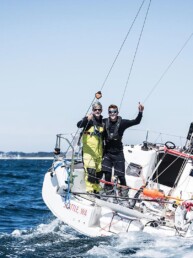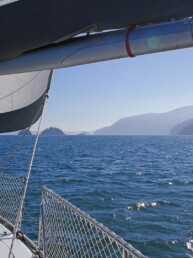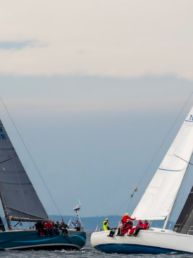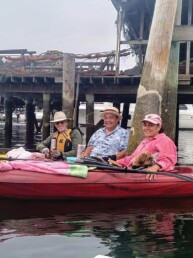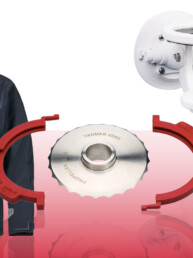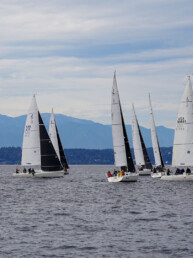This article was originally published in the August 2021 issue of 48° North.
Unfamiliar features have entered everyday life for the Totem crew. The galley is now called a kitchen; it includes a countertop box you put food in, and with a spin of the dial you wait until a sharp BEEP suggests the contents are hot. Jamie and I have daily lives once again split by a commute. Keys — several of them — tinkle from a ring on a beaded strand and are necessary tools. What’s going on?!
For the first time since calling our sailboat home in May of 2008, we have moved ashore in Puerto Peñasco, Mexico. The apartment is only a 10-minute walk from the shipyard where Totem undergoes refitting work, but the distance can feel a world apart. This transition to terra firma has drawn a fine point on differences between life on a cruising boat and life on land.
Counterintuitively, we’re experiencing a fair amount of figurative discomfort in what many would consider “more comfortable” surroundings. And, while much of this certainly must seem like normal life to the average person, we wanted to share the novelty we find in these experiences, as well as the appreciation it gives us for the simple life we’ve built afloat. It’s one we are dearly missing even while relishing some of the indulgences of this temporary shoreside existence.
Adjusting to the terminology
An early sign of our discomfort was rearranging the furniture when we moved in. Mairen used the descriptors fore and aft, and inboard and outboard, to give directions. We had a discussion and determined that there wasn’t a way to have port and starboard sides of the apartment. Then Siobhan shared a picture in our family chat group for Niall’s benefit: a plate of the gyozas she and Mairen had folded up for dinner. Niall asked if it was in the apartment galley, then corrected himself to say kitchen. Despite nearly three years on land, this is his context — and ours! We are getting better: that room with shower and toilet has mostly been called the bathroom and not the head.
Laundry
For more than a decade, a five-gallon bucket and elbow grease got our laundry clean. In 2019 we installed a washer. It offered neither additional capacity nor a dryer (there are lifelines for that), but it got clothes cleaner, and spun them from soaked to damp. Load frequency is constrained by available water, which is constrained by tank capacity and the last time we ran the watermaker.
Then along comes apartment life, which includes a washing machine that has a capacity of nearly triple triple our on-board options. It’s plumbed in and plugged in, without constrained utilities to monitor. Not only that, there is a DRYER!
Habits die hard, so most of our clothes end up hung on paracord we’ve strung across the apartment’s patio anyway. At least there’s no HOA here to object. In our pre-cruising days, our high efficiency front-loader probably did a load a day; our volume is less than a quarter of that now.
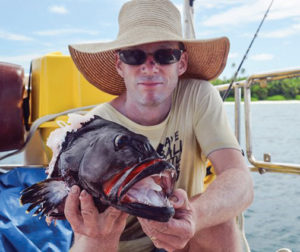
Couture
Well, clothes. We do need them, although cruisers generally wear much less. (This conveniently translates to generating less laundry, per above!) Our clothing standards are low: items are often only replaced when they are falling apart. Other cruisers don’t know or care if your boardshorts are the latest style or a trendy color. We just don’t need as much: the locker which contains the shared wardrobe for me and Jamie would have held my shoes previously… well, it might have.
With this haul out, as with previous occasions, Jamie has dug into fiberglass work. Between layup and sanding, there’s a lot of covering up (and in the process, destroying much of the clothing worn to protect his skin). In past years, we hopped north of the border and picked up pants and long-sleeved shirts sold by the pound at Goodwill: “disposable clothes”. This time, Jamie pointed out that his existing range of shorts and shirts was so far gone that those were the disposable workwear. Replacing them with new items proved a genuinely strange feeling. The overwhelming number of options in the US reminded us we are just one more consumer cog in a massive market wheel. It reaffirmed our preference for simplicity that spills into most facets of life on the water by comparison.
Groceries
While coastal cruising in Mexico, grocery shopping is a mixture of periodic deeper provisioning of staples along with walks to pick up “freshies” every few days. I’ll ask the butcher for pork by recipe and weight; then they determine the appropriate cut and selection. Sometimes there’s fresh fish from the spear or lines. Available fruit and vegetables actually vary by season; no Chilean strawberries in the cool case in November. No strawberries at all! But fortunately, there are avocados ripening somewhere in Mexico every month of the year. Being flexible in your menu is an enjoyable requirement of provisioning in small coastal villages.
Grocery shopping now looks more like it did the last time we lived on land, pre-cruising. In addition to an apartment with modern conveniences, we have the genuine cruiser luxury of a vehicle loaned by friends. It’s easy to load up that trunk. There’s no more strategic purchasing to get all the heavy things when you’re splitting a ride with a friend, or waiting until there’s a dinghy dock close to a supermarket. These days, if we’re missing a key ingredient for dinner we can just run out to pick it up — no dinghy required, and the chain supermarket is just a five minute drive away.
Garbage
When sailing in remote areas, like much of our cruising last year in the Sea of Cortez, it’s possible to have weeks between opportunities for proper garbage disposal. This necessitates paying attention to what’s brought on board, and developing practices to minimize any resulting waste. We’ve honed this skill over time, and may have no more than a three liter jug to throw away afterwards.
Our apartment’s kitchen has a standard household trash can, which could hold many of those three liter jugs. Somehow, we manage to fill it every few days — just like it did in our former land kitchen. What’s changed? Not having to worry as much about the downstream inconvenience of packaging influences our choices, and we aren’t using the reduction tactics we would on board. Our retailer options here also tend to use more packaging: the chain supermarket’s pork is on Styrofoam under shrink wrap, and isn’t handed across the counter with instructions for cooking posole.
Daily Rituals
Aboard Totem, our crew shares 47 feet of length and 14 feet of beam, which provides an interior volume smaller than the square footage of those maximum dimensions might suggest. Phrased differently, our physical proximity means there has never been a need to raise a voice to call out to another family member while at home. Apartment life could have changed this, but we’re resistant! Although we have the option to spread out between a few rooms and a patio, the girls and I sit close enough to touch at our chosen daily workstations.
What’s changed is that Jamie is at the shipyard with Totem while we’re “home” working on school and other projects much of the day. It’s a sensible divide for the tasks we’re each focused on, but the apartness is no longer our natural state. It is, on the other hand, motivation to power through and get back on board. Then other rituals can return, whether it’s hikes or gathering on a beach at sunset with our fellow cruisers.
Meanwhile, at least we’d gotten used to sleeping without the cradle’s rock of being afloat. For a couple of months, we lived aboard in the shipyard, as we always have before. Jamie called it, “The world’s flattest anchorage!” But faced with particularly messy interior work, this temporary shift to land makes sense. With the move is an opportunity for renewed gratitude for the simpler life we look forward to resuming later this year.
Behan and Jamie Gifford
Behan and Jamie Gifford set sail from Bainbridge Island in 2008 and are currently aboard Totem in Mexico. Their column for 48° North has traced Lessons Learned Cruising during a circumnavigation with their three children aboard and continued adventures afloat. Follow them at www.sailingtotem.com

